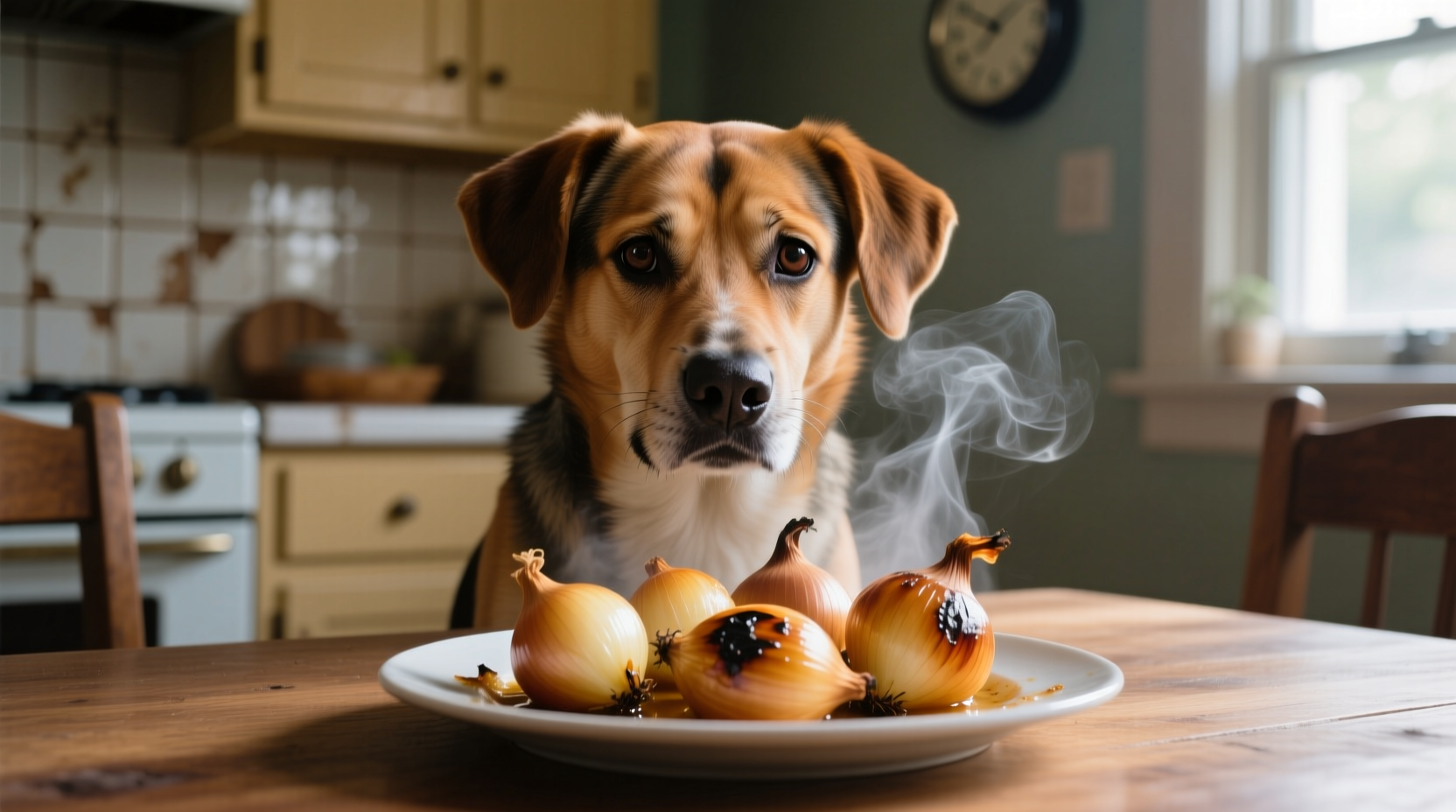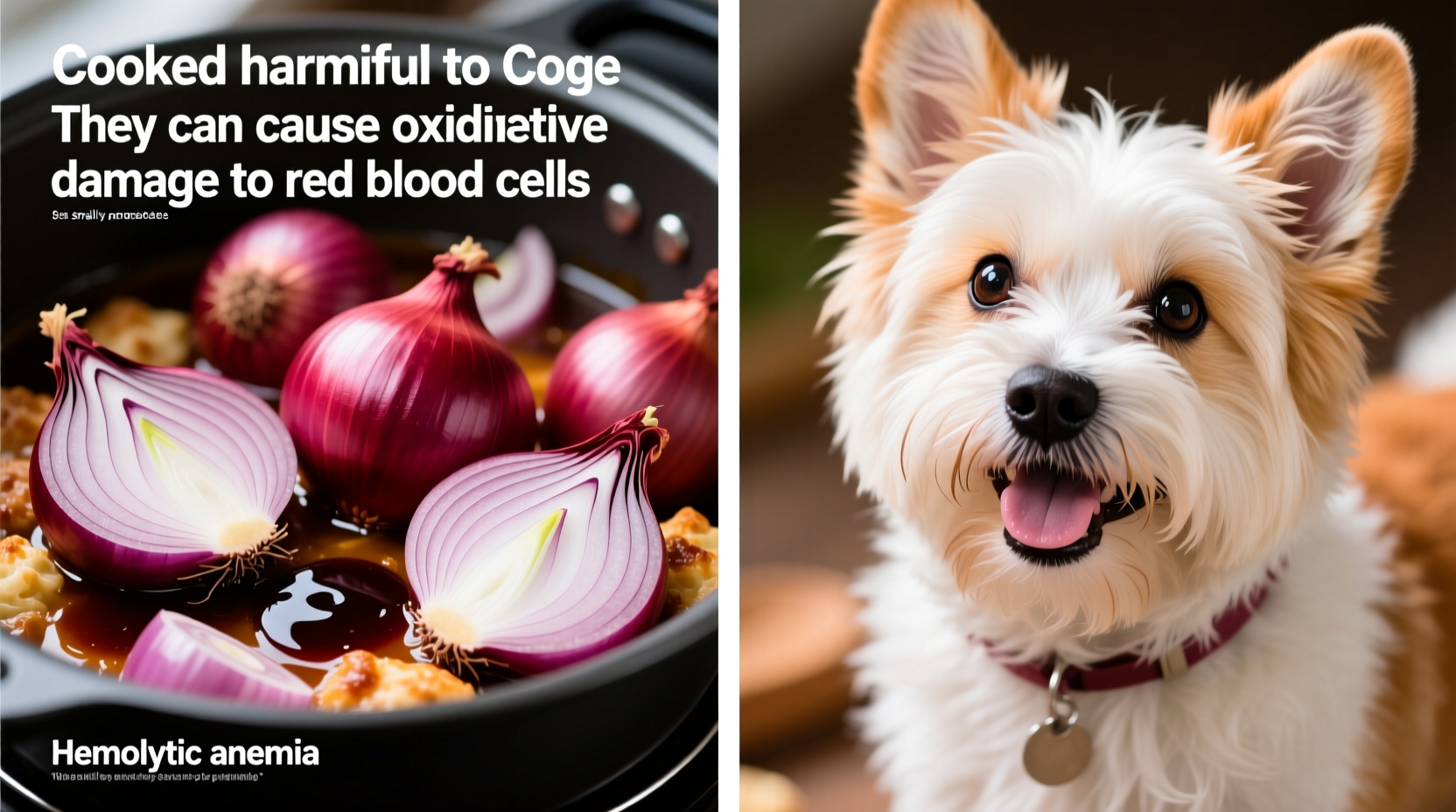Yes, cooked onions are dangerous for dogs—even in small amounts. All forms of onions (including cooked, powdered, or in sauces) contain N-propyl disulfide, which destroys red blood cells and can cause life-threatening hemolytic anemia. Symptoms may appear 24-72 hours after ingestion. If your dog consumed onions, contact your veterinarian immediately.
Many dog owners wonder whether cooked onions are safe after accidentally sharing human food with their pets. Unlike humans, dogs lack the enzyme needed to break down organosulfur compounds in Allium vegetables. This biological vulnerability makes cooked onions just as toxic as raw ones—a critical fact every pet owner should know.
Why Cooked Onions Remain Dangerous for Dogs
Cooking doesn't neutralize the toxic compounds in onions. The heat-stable N-propyl disulfide and other thiosulphates remain active, damaging canine red blood cells through oxidative stress. When these compounds enter a dog's bloodstream, they attach to hemoglobin molecules, causing:
- Formation of Heinz bodies (damaged red blood cell structures)
- Premature red blood cell destruction
- Reduced oxygen-carrying capacity
- Potential organ damage from oxygen deprivation
According to the ASPCA Animal Poison Control Center, as little as 15-30 grams of onion per kilogram of body weight can trigger toxic effects. This means even a small serving of cooked onions in human food could harm a medium-sized dog.
Symptom Timeline: What to Watch For
Onion toxicity symptoms typically follow this progression:
| Time After Ingestion | Early Symptoms | Advanced Symptoms |
|---|---|---|
| 6-24 hours | Mild lethargy, decreased appetite | N/A |
| 24-48 hours | Pale gums, increased breathing rate | Vomiting, diarrhea |
| 48-72 hours | N/A | Dark urine (hemoglobinuria), weakness, collapse |
Dr. Tina Wismer, Senior Director at ASPCA Animal Poison Control, emphasizes that "symptoms may not appear immediately, but the damage is occurring beneath the surface. By the time dogs show obvious signs, significant red blood cell destruction has already happened."

Danger Levels by Dog Size
The toxic threshold varies significantly based on your dog's weight. The Merck Veterinary Manual identifies these critical thresholds:
- Small dogs (under 20 lbs): Just 1-2 tablespoons of cooked onions can be toxic
- Medium dogs (20-50 lbs): 1/4 to 1/2 cup poses serious risk
- Large dogs (50+ lbs): More than 1/2 cup requires immediate veterinary attention
Remember that onion powder is especially dangerous—one teaspoon contains the equivalent of an entire onion. Foods like baby food, soups, gravies, and meatloaf often contain hidden onion derivatives that owners overlook.
Immediate Actions: What to Do If Your Dog Ate Onions
If your dog consumed cooked onions, follow these evidence-based steps:
- Contact your veterinarian or animal poison control immediately (ASPCA APCC: 888-426-4435)
- Do not induce vomiting unless specifically instructed—onion compounds can cause esophageal damage
- Bring the food packaging or recipe to help veterinarians assess the quantity ingested
- Monitor for symptoms every 4-6 hours for the next 72 hours
Veterinary treatment may include intravenous fluids, oxygen therapy, and in severe cases, blood transfusions. Early intervention significantly improves recovery outcomes, with most dogs making a full recovery when treated within 12 hours of ingestion.
Preventing Onion Exposure in Your Home
Protect your dog with these practical strategies:
- Store human food securely—Use latched cabinets for leftovers containing onions
- Train family members—Educate children about the dangers of sharing human food
- Read pet food labels carefully—Avoid commercial foods listing onion, garlic, or chives derivatives
- Create a pet-safe cooking zone—Keep dogs out of the kitchen during meal preparation
When cooking, remember that onion toxicity isn't limited to the bulb itself. All Allium family members—including garlic, leeks, chives, and shallots—pose similar risks. The American Kennel Club reports that "garlic is actually five times more toxic than onions," making even small amounts particularly dangerous.
Safe Flavor Alternatives for Dogs
Instead of using onions for flavor, try these dog-safe alternatives:
- Celery (chopped finely)
- Cucumbers (peeled and seeded)
- Carrots (cooked and mashed)
- Parsley (small amounts for fresh breath)
These ingredients provide flavor and nutritional benefits without the toxic risks associated with cooked onions for dogs. Always introduce new foods gradually and in moderation.
When to Seek Emergency Care
Don't wait for symptoms to appear. Contact your veterinarian immediately if your dog consumed:
- Any amount of onion powder
- More than 1 tablespoon of cooked onions per 10 pounds of body weight
- Foods containing multiple Allium vegetables (onion + garlic combinations)
- Leftover human meals with unknown onion content
Time is critical with onion toxicity cases. The Cornell University College of Veterinary Medicine emphasizes that "early decontamination and supportive care can prevent the progression to severe hemolytic anemia."











 浙公网安备
33010002000092号
浙公网安备
33010002000092号 浙B2-20120091-4
浙B2-20120091-4